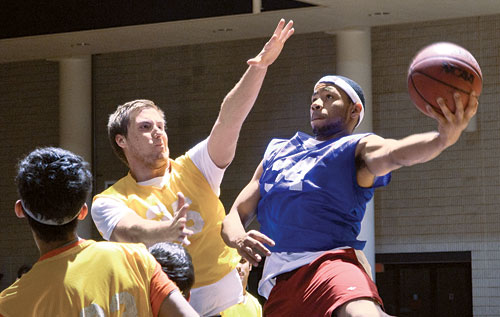Spring 2010: Of Note

Faceoff: Intramural players, above in a championship game, relish the competition.
Kay Hinton
Serious Fun
Intramural sports keep students happy, healthy, and hardcore
By Mallory Goldberg 10C
It’s the men’s intramural basketball championship game, and the score is tight. The bleachers hold a few dozen students and fraternity brothers cheering the players. While the size of the audience may not be impressive, the enthusiasm is comparable to that of a varsity men’s basketball game—all that’s missing is the Eagle merchandise, cheerleaders, and shinier uniforms.
Despite the commonly held notion that students at Division III schools don’t care about sports, Emory’s intramural program indicates otherwise. Last year, 5,846 graduate and undergraduate students played intramural sports. With that kind of participation at a school with about six thousand undergraduate students, it’s clear the students play to win.
Josh Levin-Scherz 11C has played intramural football, basketball, and softball since his first year at Emory. Since joining a fraternity his freshman year, Levin-Scherz has competed with Alpha Epsilon Pi. They recently participated in the men’s championship game against the winning team, S-Class. “Bragging rights are important among the fraternities,” he says. “Each frat tries to accumulate the most points each year so they can win All-Row.”
Unlike some college intramural programs in which Greek organizations play in a separate league, Emory’s students all compete together. Most of the Greek teams play in the A-league, where students take the game fairly seriously, according to Intramural Coordinator Daniel Overstreet. “It’s made up of a ton of former high school athletes,” Levin-Scherz says. “The A-leagues are also littered with athletes who used to play for Emory, but decided for whatever reason to stop playing.”
Randye Rand 10C, who also played in the men’s championship game for S-Class, says intramurals have made it possible to relish sports while experiencing other aspects of university life. Rand made the decision not to play varsity sports while weighing college programs.
“There are a lot of really good athletes here who figured they would be happier and go further by choosing an academic institution like Emory, instead of pursuing sports at top athletic programs in the country,” Rand says. “But that love for the sport never dies, so intramural sports is a way to satisfy that hunger to compete in organized sports without sacrificing the time that athletics requires.”
Courtney Rivkind 13C also considered choosing a school where she could play varsity basketball. But after her first season of intramural basketball for her sorority, Alpha Epsilon Phi, Rivkind is glad the program doesn’t demand the same level of competition or skill. “I didn’t think I was passionate enough about basketball, and to play a varsity sport you really have to love it,” Rivkind says. “A lot of people are playing intramurals to stay in shape while having fun, so it is not taken as seriously.”
In addition to basketball, intramural sports include flag football, softball, volleyball, soccer, and court hockey. Last season, basketball was the most popular with 107 teams (co-rec, male, and female) followed by flag football and soccer. While most teams don’t have coaches, intramural players recognize the advantages that team practices hold. “More important than practicing is simply playing together,” Levin-Sherz says.